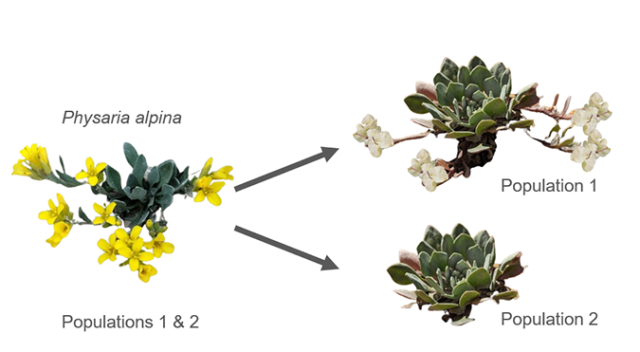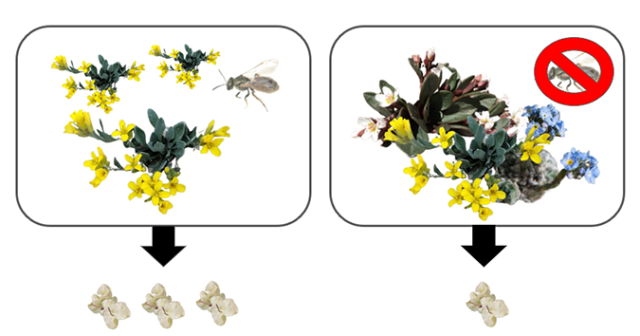Studying Pollen Limitation of the Avery Peak Twinpod
Effective conservation requires baseline information on how a species exists in its environment. Rare species contribute to our global biodiversity like the Avery Peak Twinpod (Physaria alpina), which only occurs in certain alpine areas of Colorado and is considered imperiled due to its limited distribution and high vulnerability to climate change.
In the summer of 2023, researchers at Denver Botanic Gardens visited two flowering populations of this species. But upon returning to collect seeds, they found one population had produced fruit and the other hadn’t produced fruit at all. If a population does not reproduce, its persistence could be affected.

Figure depicting different populations’ reproduction (not to scale). Flowering Physaria alpina image by John Powers. Images of Physaria alpina fruit by Jared Shorma. Physaria alpina rosette image by My-Lan Le.
As a graduate student that led me to the question: What affects the reproduction within and between populations of the Avery Peak Twinpod? One way a plant may have low reproductive output is if it’s pollen-limited, which means it’s not receiving enough high-quality pollen to produce fruits and seeds.
Pollen limitation can occur in many ways. Using an example of two plants where one plant produces more fruits than the other, we can imagine some of the environmental variables that could cause pollen limitation. These plants may be self-incompatible — they cannot self-fertilize. If a plant needs pollen from another individual to produce fruit, being around more members of its own species may increase its chances of receiving appropriate pollen.
If a plant needs a pollinator to reproduce, the pollinator may be more attracted to a large floral display and visit more plants of the same species. A plant that has many other species nearby may have competition if those plants are more attractive to the pollinator or result in the pollinator depositing the wrong kind of pollen on the plant. The plant's pollinator could be missing at the site where the plant lives. All these variables may be interacting with each other.

Figure depicting different causes of pollen limitation, leading to different amounts of reproduction (not to scale). Image of flowering Physaria alpina by John Powers. Images of Physaria alpina fruit by Jared Shorma. Image of Claytonia megarhiza by Matt Berger. Image of Eritrichium argenteum by Patrick Alexander. Image of Lasioglossum sp. by Thompson Hyggen.
To test whether the populations are pollen-limited, I’ll perform a pollen supplementation experiment at different populations of the Avery Peak Twinpod. Pollen-supplemented individuals will receive pollen from other individuals. The control group won’t receive pollen. Later, I’ll count the developed fruit and seeds from each plant and compare the results within and between populations.
I’ll work on this research this summer with support from Denver Botanic Gardens, Colorado Native Plant Society, Garden Club of America and Field Inclusive and permission from the U.S. Forest Service and Bureau of Land Management.
This article was contributed by graduate student My-Lan Le.
Add new comment